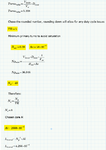bowman1710
Full Member level 3
Hi guys,
I'm trying to get a final idea in my head about what to do with designs and their magnetising inductance, I have put several posts on here about magnetising inductance but I feel if I put more into what I'm asking I might get more back with previously me just asking "what is the correct magnetising inductance?"
Attached is my way of thinking/working outs that I have done, with what people have said in the past it is all about flux etc first, which is how i have done it from the start. I have worked out what turns ratio I need, the minimum amount of primary turns needed with the core size and desired Sat limit and worked out the primary inductance given that amount of turns

As you can see from my design it leaves me with 4.3mH worth of primary inductance now given a switching frequency of 333KHz and a minimum input voltage of 250V with a 30W capability you would expect
Xl=2*pi*333KHz*4.3mH=9Kohm
Im=Vin/Xl=250/9Kohm=27.7mA
If you work out the input current needed as a rough ball park with 80% efficiency
Iin=(30*1.2)/250=144mA
So the Im is nearly 20% of the Iin value, so at what point do you say well.......its not going into saturation but the magnetizing current is too high. Does this need more turns? Will more turn cause too high of inductance and cause spikes on the MOSFETs? Where do you draw the line and say well it needs to be this?
I'm trying to get a final idea in my head about what to do with designs and their magnetising inductance, I have put several posts on here about magnetising inductance but I feel if I put more into what I'm asking I might get more back with previously me just asking "what is the correct magnetising inductance?"
Attached is my way of thinking/working outs that I have done, with what people have said in the past it is all about flux etc first, which is how i have done it from the start. I have worked out what turns ratio I need, the minimum amount of primary turns needed with the core size and desired Sat limit and worked out the primary inductance given that amount of turns

As you can see from my design it leaves me with 4.3mH worth of primary inductance now given a switching frequency of 333KHz and a minimum input voltage of 250V with a 30W capability you would expect
Xl=2*pi*333KHz*4.3mH=9Kohm
Im=Vin/Xl=250/9Kohm=27.7mA
If you work out the input current needed as a rough ball park with 80% efficiency
Iin=(30*1.2)/250=144mA
So the Im is nearly 20% of the Iin value, so at what point do you say well.......its not going into saturation but the magnetizing current is too high. Does this need more turns? Will more turn cause too high of inductance and cause spikes on the MOSFETs? Where do you draw the line and say well it needs to be this?